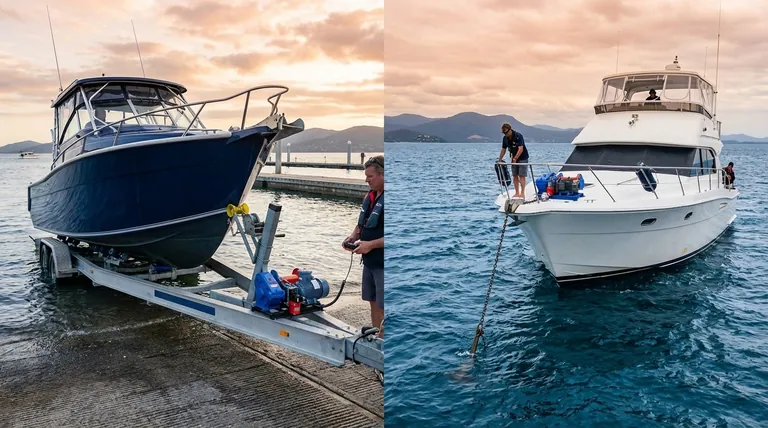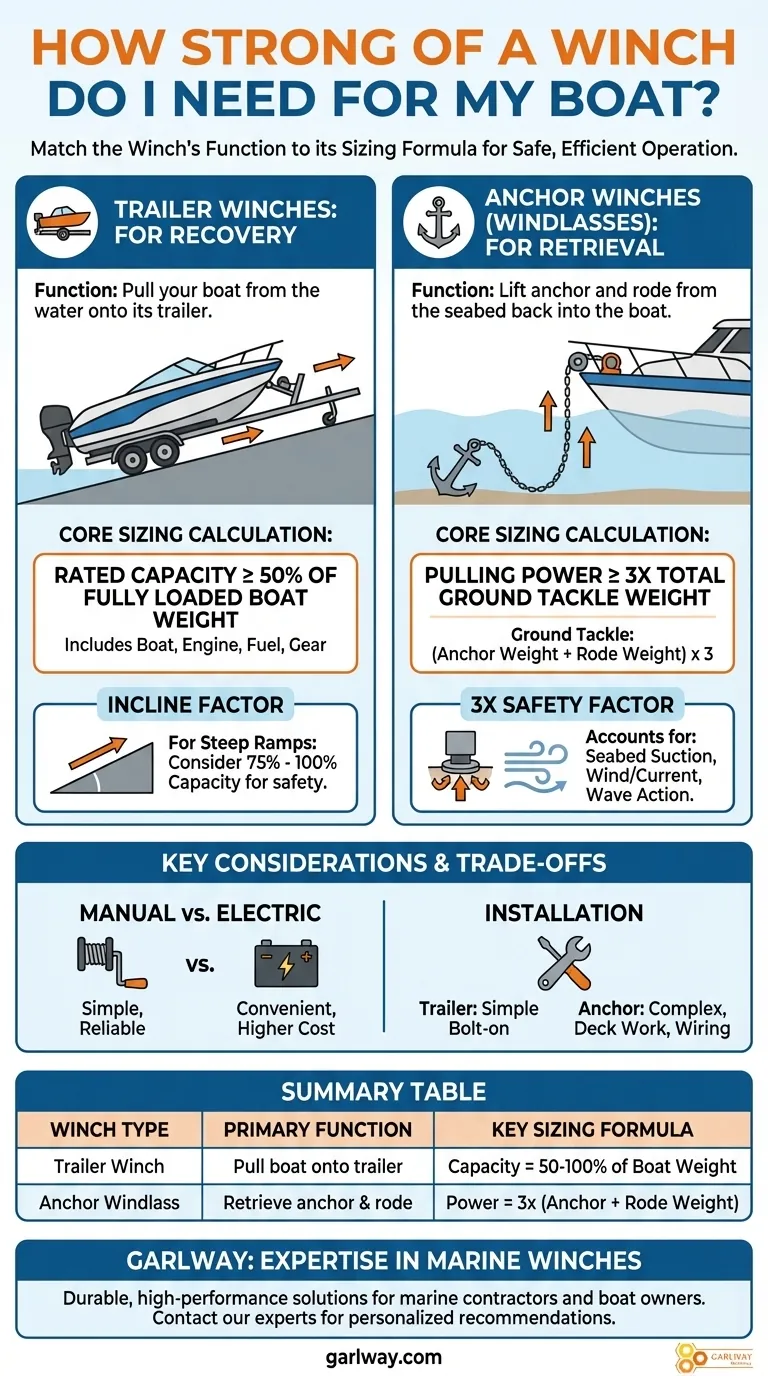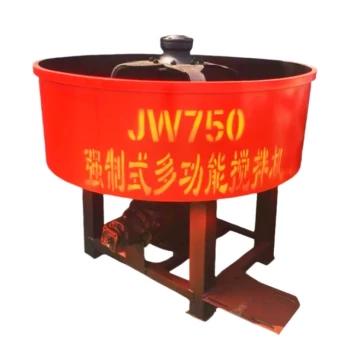The strength of winch you need depends entirely on whether you are pulling your boat onto a trailer or pulling your anchor up from the seabed. For a trailer winch, the rule of thumb is a capacity of at least half your boat's total weight. For an anchor winch, also known as a windlass, the required pulling power is three times the total weight of your anchor and rode (the chain and/or rope).
Your core task is to match the winch's function to its sizing formula. A trailer winch overcomes rolling friction and gravity based on the boat's weight, while an anchor winch overcomes the dead weight of your ground tackle against wind and current.

The Critical First Question: Trailer Winch or Anchor Windlass?
These two tools serve entirely different purposes and are sized using different metrics. Confusing them can lead to a purchase that is either dangerously underpowered or unnecessarily expensive.
Trailer Winches: For Recovery
A trailer winch is used to pull your boat from the water onto its trailer. Its job is to overcome the boat's weight on an incline, aided by the trailer's rollers or bunks.
Anchor Winches (Windlasses): For Retrieval
An anchor winch, or windlass, is mounted on the bow of your boat. Its sole purpose is to lift your anchor and rode (chain/rope) from the seabed back into the boat.
Sizing a Boat Trailer Winch
Choosing a trailer winch is a calculation based on the total weight of your vessel and the environment where you launch and retrieve it.
The Core Calculation
As a starting point, your winch's rated capacity should be at least half the weight of your fully loaded boat. This includes the boat, the engine, fuel, water, and all your gear.
Why Incline is the Real Deciding Factor
A shallow, well-maintained boat ramp makes recovery easy. However, a steep or high-friction ramp (like gravel or old concrete) dramatically increases the force required.
For consistently steep ramps, you should select a winch with a capacity closer to 75% or even 100% of your boat's total weight for a greater margin of safety and reduced strain on the equipment.
Sizing an Anchor Winch (Windlass)
Sizing an anchor windlass is not about the boat's weight, but about the weight of the equipment it has to lift, known as ground tackle.
The Ground Tackle Formula
The industry standard is to choose a windlass with a maximum pulling power of at least three times the total weight of your ground tackle.
The formula is simple: (Anchor Weight + Rode Weight) x 3 = Minimum Windlass Pulling Power.
Calculating Your Rode Weight
First, determine the weight of your anchor. Then, calculate the weight of your entire length of chain or rope. Chain manufacturers provide a "weight per foot/meter" specification.
For example, a 35 lb anchor with 100 feet of 1/4" chain (at 0.75 lbs/ft) has a total ground tackle weight of 110 lbs (35 + 75). Using the formula, you would need a windlass with a minimum pulling power of 330 lbs.
Why the 3x Safety Factor is Non-Negotiable
This multiplier isn't arbitrary. It accounts for the significant additional forces the windlass must overcome, including:
- The suction of a well-dug-in anchor in mud or sand.
- The pressure of wind and current acting on the hull of your boat.
- The added strain from wave action during retrieval.
Understanding the Trade-offs and Key Considerations
Beyond pure pulling power, several practical factors influence your final choice.
Manual vs. Electric Power
A manual winch is simple, reliable, and inexpensive. An electric winch offers incredible convenience at the cost of a higher price, complex wiring installation, and reliance on your boat's battery power.
Deck Space and Mounting
An anchor windlass requires a flat, strong section of the deck for mounting. Crucially, it must align perfectly with your bow roller to prevent the chain or rope from chafing and to ensure smooth operation.
Installation Complexity
While a trailer winch is a simple bolt-on component, installing an anchor windlass can be a significant project. It often involves cutting into the deck, running heavy-gauge electrical cables, and potentially reinforcing the mounting area.
Making the Right Choice for Your Boat
Use your primary goal to determine the correct calculation and make a confident decision.
- If your primary focus is a TRAILER winch: Start with a capacity of 50-75% of your boat's fully loaded weight and increase it if you frequently use steep or poorly maintained ramps.
- If your primary focus is an ANCHOR winch (windlass): Precisely calculate the total weight of your anchor and rode, then multiply that number by three to find your minimum required pulling power.
Choosing the right winch is a foundational element of safe and stress-free boating.
Summary Table:
| Winch Type | Primary Function | Key Sizing Formula | Key Considerations |
|---|---|---|---|
| Trailer Winch | Pull boat onto trailer | Capacity = 50-100% of boat's loaded weight | Ramp incline, rolling friction |
| Anchor Windlass | Retrieve anchor & rode | Pulling Power = 3x (Anchor Weight + Rode Weight) | Seabed suction, wind/current |
Ensure Safe and Efficient Boat Handling with the Right Winch
Choosing the correct winch is critical for the safety of your crew and vessel. GARLWAY specializes in durable, high-performance construction and marine winches, offering reliable solutions for demanding applications.
Whether you're a marine contractor needing robust equipment or a boat owner seeking dependable trailering and anchoring power, our expertise ensures you get a winch matched perfectly to your load requirements.
Contact our experts today to discuss your specific needs and find the ideal GARLWAY winch for your project. We'll help you calculate the precise capacity you need for safe, effortless operation.
Get Your Personalized Winch Recommendation →
Visual Guide

Related Products
- Electric and Hydraulic Winch for Heavy Duty Applications
- Warn Winch Windlass Boat Trailer Winch
- Electric 120V Boat Winch by Badlands
- Best 18000 Pound Drum Anchor Trailer Winch
- 12000 lb Heavy Duty Electric Boat Winch
People Also Ask
- How is an electric winch powered? Unlock the Power Conversion System for Heavy Lifting
- Do electric winches have brakes? Essential Safety for Your Heavy-Duty Pulling
- How long can you run an electric winch? Master Safe, Efficient Vehicle Recovery
- How to maintain an electric winch? Ensure Peak Performance & Reliability for Your Projects
- How do I choose an electric winch? A guide to safe and effective pulling power.



















